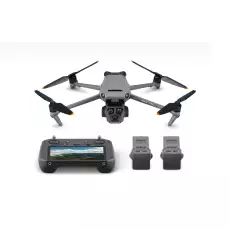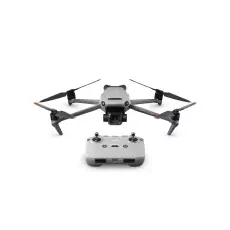In the Box:
1x Mavic 3 Pro
1x RC Pro
1x RC Pro Control Sticks (Pair)
3x Mavic 3 Intelligent Flight Battery
6x Mavic 3 Low-Noise Propellers (Pair)
1x 100W USB-C Power Adapter AC Power Cable
1x 100W USB-C Power Adapter
2x USB-C to USB-C Cable
1x Mavic 3 Battery Charging Hub (100W)
1x Mavic 3 Pro Storage Cover
1x Mavic 3 Pro ND Filters Set (ND8/16/32/64)
1x Shoulder Bag
DJI Mavic 3 Pro
General
Takeoff Weight
Mavic 3 Pro: 958 g
Mavic 3 Pro Cine: 963 g
Dimensions
Folded (without propellers): 231.1×98×95.4 mm (L×W×H)
Unfolded (without propellers): 347.5×290.8×107.7 mm (L×W×H)
Max Ascent Speed
8 m/s
Max Descent Speed
6 m/s
Max Horizontal Speed (at sea level, no wind)
21 m/s
Max Takeoff Altitude
6000 m
Max Flight Time
43 minutes
Measured in a controlled test environment. Specific test conditions are as follows: flying at a constant speed of 32.4 kph in a windless environment at sea level, with APAS off, AirSense off, camera parameters set to 1080p/24fps, video mode off, and from 100% battery level until 0%. Results may vary depending on the environment, actual use, and firmware version.
Max Hovering Time
37 minutes
Measured in a controlled test environment. Specific test conditions are as follows: hovering in a windless environment at sea level, with APAS off, AirSense off, camera parameters set to 1080p/24fps, video mode off, and from 100% battery level until 0%. Results may vary depending on the environment, actual use, and firmware version.
Max Flight Distance
28 km
Max Wind Speed Resistance
12 m/s
Max Tilt Angle
35°
Operating Temperature
-10° to 40° C (14° to 104° F)
Global Navigation Satellite System
GPS + Galileo + BeiDou
Hovering Accuracy Range
Vertical:
±0.1 m (with vision positioning)
±0.5 m (with GNSS positioning)
Horizontal:
±0.3 m (with vision positioning)
±0.5 m (with high-precision positioning system)
Internal Storage
Mavic 3 Pro: 8 GB (approx. 7.9GB available space)
Mavic 3 Pro Cine: 1 TB (approx. 934.8GB available space)
Camera
Image Sensor
Hasselblad Camera: 4/3 CMOS, Effective Pixels: 20 MP
Medium Tele Camera: 1/1.3-inch CMOS, Effective Pixels: 48 MP
Tele Camera: 1/2-inch CMOS, Effective Pixels: 12 MP
Lens
Hasselblad Camera
FOV: 84°
Format Equivalent: 24mm
Aperture: f/2.8-f/11
Focus: 1 m to ∞
Medium Tele Camera
FOV: 35°
Format Equivalent: 70mm
Aperture: f/2.8
Focus: 3 m to ∞
Tele Camera
FOV: 15°
Format Equivalent: 166mm
Aperture: f/3.4
Focus: 3 m to ∞
ISO Range
Video
Normal and Slow Motion:
100-6400 (Normal)
400-1600 (D-Log)
100-1600 (D-Log M)
100-1600 (HLG)
Night:
800-12800 (Normal)
Photo
100-6400
Shutter Speed
Hasselblad Camera: 8-1/8000 s
Medium Tele Camera: 2-1/8000 s
Tele Camera: 2-1/8000 s
Max Image Size
Hasselblad Camera: 5280×3956
Medium Tele Camera: 8064×6048
Tele Camera: 4000×3000
Still Photography Modes
Hasselblad Camera
Single Shot: 20 MP
Burst Shooting: 20 MP, 3/5/7 frames
Automatic Exposure Bracketing (AEB): 20 MP, 3/5 frames at 0.7 EV step
Timed: 20 MP, 2/3/5/7/10/15/20/30/60 s
Medium Tele Camera
Single Shot: 12 MP or 48 MP
Burst Shooting: 12 MP or 48 MP, 3/5/7 frames
Automatic Exposure Bracketing (AEB): 12 MP or 48 MP, 3/5 frames at 0.7 EV step
Timed:
12 MP: 2/3/5/7/10/15/20/30/60 s
48 MP: 7/10/15/20/30/60 s
Tele Camera
Single Shot: 12 MP
Burst Shooting: 12 MP, 3/5/7 frames
Automatic Exposure Bracketing (AEB): 12 MP, 3/5 frames at 0.7 EV step
Timed: 12 MP, 2/3/5/7/10/15/20/30/60 s
Photo Format
JPEG/DNG (RAW)
Video Resolution
Hasselblad Camera
Apple ProRes 422 HQ
Apple ProRes 422
Apple ProRes 422 LT
5.1K: 5120×2700@24/25/30/48/50fps
DCI 4K: 4096×2160@24/25/30/48/50/60/120*fps
4K: 3840×2160@24/25/30/48/50/60/120*fps
H.264/H.265
5.1K: 5120×2700@24/25/30/48/50fps
DCI 4K: 4096×2160@24/25/30/48/50/60/120*fps
4K: 3840×2160@24/25/30/48/50/60/120*fps
FHD: 1920×1080@24/25/30/48/50/60/120*/200*fps
* Recording frame rates. The corresponding video plays as slow-motion video.
Medium Tele Camera
Apple ProRes 422 HQ
Apple ProRes 422
Apple ProRes 422 LT
4K: 3840×2160@24/25/30/48/50/60fps
H.264/H.265
4K: 3840×2160@24/25/30/48/50/60fps
FHD: 1920×1080@24/25/30/48/50/60fps
Tele Camera
Apple ProRes 422 HQ
Apple ProRes 422
Apple ProRes 422 LT
4K: 3840×2160@24/25/30/48/50/60fps
H.264/H.265
4K: 3840×2160@24/25/30/50/60fps
FHD: 1920×1080@24/25/30/50/60fps
Video Format
MP4/MOV (MPEG-4 AVC/H.264, HEVC/H.265)
MOV (Apple ProRes 422 HQ/422/422 LT)
Max Video Bitrate
H.264/H.265: 200 Mbps
Apple ProRes 422 HQ: 3772 Mbps
Apple ProRes 422: 2514 Mbps
Apple ProRes 422 LT: 1750 Mbps
Supported File System
exFAT
Color Mode and Sampling Method
Hasselblad Camera
Normal:
10-bit 4:2:2 (Apple ProRes 422 HQ/422/422 LT)
8-bit 4:2:0 (H.264/H.265)
D-Log:
10-bit 4:2:2 (Apple ProRes 422 HQ/422/422 LT)
10-bit 4:2:0 (H.264/H.265)
HLG/D-Log M:
10-bit 4:2:2 (Apple ProRes 422 HQ/422/422 LT)
10-bit 4:2:0 (H.265)
Medium Tele Camera
Normal:
10-bit 4:2:2 (Apple ProRes 422 HQ/422/422 LT)
8-bit 4:2:0 (H.264/H.265)
HLG/D-Log M:
10-bit 4:2:2 (Apple ProRes 422 HQ/422/422 LT)
10-bit 4:2:0 (H.265)
Tele Camera
Normal:
10-bit 4:2:2 (Apple ProRes 422 HQ/422/422 LT)
8-bit 4:2:0 (H.264/H.265)
Digital Zoom (only in Normal Video Mode and Explore Mode)
Hasselblad Camera: 1-3x
Medium Tele Camera: 3-7x
Tele Camera: 7-28x
Gimbal
Stabilization
3-axis mechanical gimbal (tilt, roll, pan)
Mechanical Range
Tilt: -140° to 50°
Roll: -50° to 50°
Pan: -23° to 23°
Controllable Range
Tilt: -90° to 35°
Pan: -5° to 5°
Max Control Speed (tilt)
100°/s
Angular Vibration Range
Hovering Without Wind: ±0.001°
Normal Mode: ±0.003°
Sport Mode: ±0.005°
Sensing
Sensing Type
Omnidirectional binocular vision system, supplemented with an infrared sensor at the bottom of the aircraft
Forward
Measurement Range:
0.5-20 m
Detection Range:
0.5-200 m
Effective Sensing Speed:
Flight Speed ≤ 15 m/s
FOV:
Horizontal 90°, Vertical 103°
Backward
Measurement Range:
0.5-16 m
Effective Sensing Speed:
Flight Speed ≤ 12 m/s
FOV:
Horizontal 90°, Vertical 103°
Lateral
Measurement Range:
0.5-25 m
Effective Sensing Speed:
Flight Speed ≤ 15 m/s
FOV:
Horizontal 90°, Vertical 85°
Upward
Measurement Range:
0.2-10 m
Effective Sensing Speed:
Flight Speed ≤ 6 m/s
FOV:
Front and Back 100°, Left and Right 90°
Downward
Measurement Range:
0.3-18 m
Effective Sensing Speed:
Flight Speed ≤ 6 m/s
FOV:
Front and Back 130°, Left and Right 160°
Operating Environment
Forward, Backward, Left, Right, and Upward:
surfaces with discernible patterns and adequate lighting (lux > 15)
Downward:
surfaces with discernible patterns, diffuse reflectivity > 20% (e.g. walls, trees, people), and adequate lighting (lux > 15)
Video Transmission
Video Transmission System
O3+
Live View Quality
Remote Controller:
1080p/30fps, 1080p/60fps
Operating Frequency
2.400-2.4835 GHz
5.725-5.850 GHz
Transmitter Power (EIRP)
2.4 GHz:
< 33 dBm (FCC)
< 20 dBm (CE/SRRC/MIC)
5.8 GHz:
< 33 dBm (FCC)
< 30 dBm (SRRC)
< 14 dBm (CE)
Max Transmission Distance (unobstructed, free of interference)
FCC: 15 km
CE: 8 km
SRRC: 8 km
MIC: 8 km
Measured in an unobstructed outdoor environment free of interference. The above data shows the farthest communication range for one-way, non-return flights under each standard. During your flight, please pay attention to RTH reminders in the DJI Fly app.
Max Transmission Distance (unobstructed, with interference)
Strong Interference: Urban landscape, approx. 1.5-3 km
Medium Interference: Suburban landscape, approx. 3-9 km
Low Interference: Suburb/seaside, approx. 9-15 km
Data tested under FCC standard in unobstructed environments with typical interference. Used for reference purposes only and provides no guarantee for actual transmission distance.
Max Transmission Distance (obstructed, with interference)
Low Interference and Obstructed by Buildings: approx. 0-0.5 km
Low Interference and Obstructed by Trees: approx. 0.5-3 km
Data tested under FCC standard in environments with typical low interference. Used for reference purposes only and provides no guarantee for actual transmission distance.
Max Download Speed
O3+:
5.5 MB/s (with DJI RC-N1 Remote Controller)
15 MB/s (with DJI RC Pro)
5.5 MB/s (with DJI RC)
Wi-Fi 6: 80 MB/s*
* Measured in a laboratory environment with little interference in countries/regions that support both 2.4 GHz and 5.8 GHz, with footage saved to the internal storage. Download speeds may vary depending on the actual conditions.
Lowest Latency
130 ms (with DJI RC-N1 Remote Controller)
120 ms (with DJI RC Pro)
130 ms (with DJI RC)
Depending on the actual environment and mobile device.
Antenna
4 antennas, 2T4R
Battery
Capacity
5000 mAh
Weight
335.5 g
Nominal Voltage
15.4 V
Max Charging Voltage
17.6 V
Type
Li-ion 4S
Energy
77 Wh
Charging Temperature
5° to 40° C (41° to 104° F)
Charging Time
Approx. 96 minutes
Use the included data cable of the DJI 65W Portable Charger.
Approx. 70 minutes
Use the DJI 100W USB-C Power Adapter and DJI Mavic 3 Series 100W Battery Charging Hub.
Charger
Input
DJI 65W Portable Charger:
100-240 V (AC), 50-60 Hz, 2 A
DJI 100W USB-C Power Adapter:
100-240 V (AC), 50-60 Hz, 2.5 A
Output
DJI 65W Portable Charger:
USB-C:
5 V, 5 A
9 V, 5 A
12 V, 5 A
15 V, 4.3 A
20 V, 3.25 A
5-20 V, 3.25 A
USB-A:
5 V, 2 A
DJI 100W USB-C Power Adapter:
Max 100 W (total)
When both ports are used, the max output power of one port is 82 W, and the charger will dynamically allocate the output power of the two ports according to the power load.
Rated Power
DJI 65W Portable Charger: 65 W
DJI 100W USB-C Power Adapter: 100 W
Battery Charging Hub
Input
USB-C: 5-20 V, max 5 A
Output
Battery Port: 12-17.6 V, max 5 A
Rated Power
Battery Charging Hub: 65 W
Battery Charging Hub (100W): 100 W
Charging Type
Three batteries charged in sequence.
Compatibility
DJI Mavic 3 Intelligent Flight Battery
Car Charger
Input
Car Power Input:
12.7-16 V, 6.5 A, rated voltage 14 V (DC)
Output
USB-C:
5 V, 5 A
9 V, 5 A
12 V, 5 A
15 V, 4.3 A
20 V, 3.25 A
5-20 V, 3.25 A
USB-A:
5 V, 2 A
Rated Power
65 W
Charging Temperature
5° to 40° C (41° to 104° F)
Storage
Recommended microSD Cards
Lexar 1066x 64GB V30 A2 microSDXC
Lexar 1066x 128GB V30 A2 microSDXC
Lexar 1066x 256GB V30 A2 microSDXC
Lexar 1066x 512GB V30 A2 microSDXC
SanDisk High Endurance 64GB V30 microSDXC
SanDisk High Endurance 128GB V30 microSDXC
SanDisk High Endurance 256GB V30 microSDXC
Kingston Canvas Go! Plus 64GB V30 A2 microSDXC
Kingston Canvas Go! Plus 128GB V30 A2 microSDXC
Kingston Canvas Go! Plus 256GB V30 A2 microSDXC
Kingston Canvas Go! Plus 512GB V30 A2 microSDXC
Samsung EVO Plus 512GB V30 A2 microSDXC
Samsung PRO Plus 256GB V30 A2 microSDXC
Samsung PRO Plus 512GB V30 A2 microSDXC








